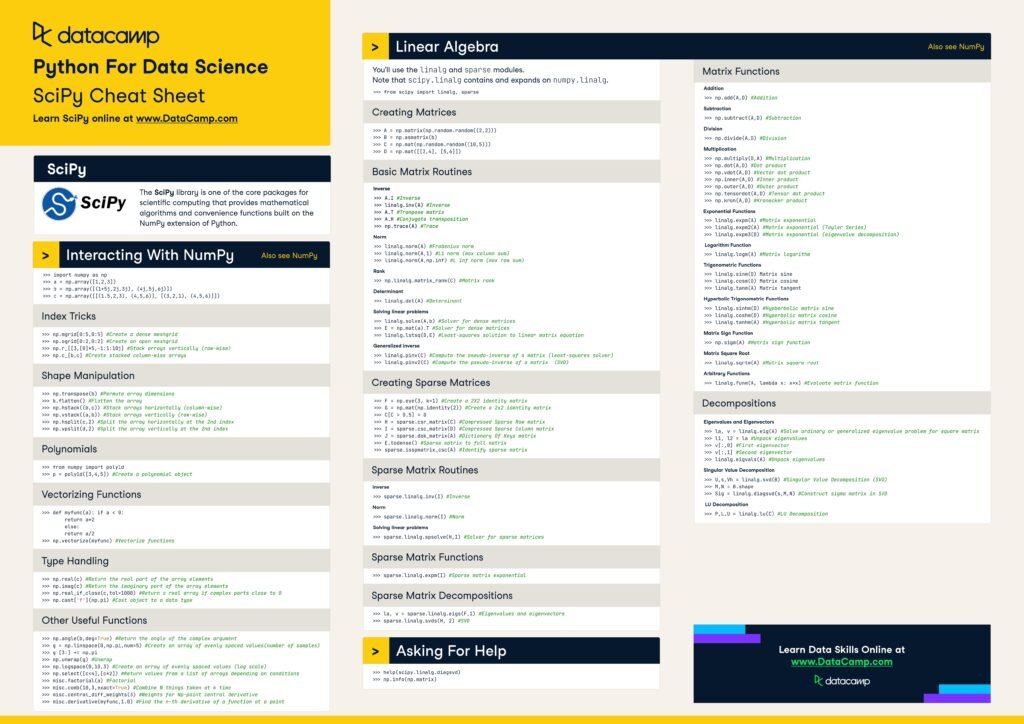SciPy is a powerful open-source library built on NumPy, designed for advanced scientific and technical computing. It provides a wide array of modules for optimization, linear algebra, integration, and more, making it a go-to library for data science and machine learning enthusiasts. In this Python SciPy tutorial, we will explore the core features of SciPy, its applications, and how to leverage it for complex computations.

Cheatsheet click here
What is SciPy?
SciPy is a Python library that enhances NumPy’s capabilities by offering additional functions and modules for mathematical, scientific, and engineering tasks. Whenever you are solving equations, conducting statistical tests, or working on signal processing, SciPy not only simplifies complex computations but also ensures efficiency and accuracy with its robust set of tools.
Why Use SciPy?
SciPy is widely used because of its:
- Versatility: It covers a broad spectrum of scientific computing needs, from statistics to Fourier transforms.
- Efficiency: Built on NumPy, SciPy is optimized for high performance.
- Ease of Use: It provides a user-friendly interface for solving advanced problems.
Key Features of SciPy
Optimization
The scipy.optimize module helps solve optimization problems, such as minimizing or maximizing functions.
from scipy.optimize import minimize
def func(x):
return x**2 + 3*x + 2
result = minimize(func, x0=0)
print(result) Integration
The scipy.integrate module allows numerical integration and solving differential equations.
from scipy.integrate import quad
def func(x):
return x**2
result, error = quad(func, 0, 2)
print(result) Linear Algebra
The scipy.linalg module provides advanced linear algebra functions, including matrix operations and decompositions.
from scipy.linalg import det matrix = [[1, 2], [3, 4]] print(det(matrix))
Signal Processing
The scipy.signal module is ideal for working with signals, offering filters, transformations, and analysis tools.
Statistics
The scipy.stats module simplifies statistical analysis with probability distributions, hypothesis tests, and more.
How to Install SciPy
To use SciPy, install it using pip:
pip install scipy
Important topics in SciPy
- SciPy Home
- SciPy Intro
- SciPy Getting Started
- SciPy Constants
- SciPy Optimizers
- SciPy Sparse Data
- SciPy Graphs
- SciPy Spatial Data
- SciPy Matlab Arrays
- SciPy Interpolation
- SciPy Significance Tests
SciPy Home
SciPy Home is the entry point to the SciPy library, offering access to its extensive documentation and modules for scientific computing. It provides a comprehensive overview of what SciPy offers, including tools for optimization, integration, linear algebra, and more.
SciPy Intro
SciPy Intro introduces the basics of the library, explaining its purpose and how it builds on NumPy to enable advanced scientific computations. It covers an overview of its modules, installation instructions, and key benefits for researchers and developers.
SciPy Getting Started
SciPy Getting Started guides beginners by showing them how to install the library, understand its core structure, and run their first SciPy program. It includes step-by-step instructions to ensure a smooth onboarding experience for new users.
SciPy Constants
The SciPy Constants module provides a wide range of physical and mathematical constants, such as the speed of light and Planck’s constant. Moreover, it simplifies computations involving fixed values by offering a standardized and reliable source, ensuring consistency across calculations.
SciPy Optimizers
SciPy Optimizers are tools within the scipy.optimize module that help solve optimization problems. Whether minimizing a function or finding roots, this module provides robust methods like gradient-based and evolutionary algorithms.
SciPy Sparse Data
The SciPy Sparse Data module is designed to handle large datasets efficiently by representing them in sparse matrix formats. It offers memory-efficient storage and fast computations for data with many zero entries, common in scientific and engineering applications.
SciPy Graphs
SciPy Graphs, found in the scipy.sparse.csgraph module, provide tools for working with graph structures. It includes algorithms for shortest paths, connected components, and minimum spanning trees, making it ideal for network analysis and optimization.
SciPy Spatial Data
The SciPy Spatial Data module, accessible via scipy.spatial, deals with geometric computations and spatial queries. It includes features like nearest neighbors search, Delaunay triangulation, and Voronoi diagrams, crucial for 3D modeling and spatial analytic
SciPy Matlab Arrays
SciPy Matlab Arrays enable seamless interaction between Python and MATLAB by offering methods to read and write .mat files. This facilitates data exchange and interoperability between the two platforms for advanced numerical computations.
SciPy Interpolation
The SciPy Interpolation module provides tools to interpolate data points and create smooth curves or surfaces. It is particularly useful for modeling and visualizing datasets, especially in scenarios where direct measurements are unavailable.
SciPy Significance Tests
SciPy Significance Tests, available in the scipy.stats module, offer statistical tools to determine the significance of datasets. These tests include t-tests, chi-square tests, and ANOVA, helping in hypothesis testing and data analysis.
Applications of SciPy
- Data Science: Cleaning, analyzing, and transforming data.
- Machine Learning: Preprocessing data and implementing algorithms.
- Scientific Research: Modeling physical and biological systems.
- Signal Processing: Filtering and analyzing time-series data.
Best Practices for Using SciPy
- Combine SciPy with other libraries like NumPy and Pandas for efficient workflows.
- Use modules specific to your tasks to streamline computations.
- Leverage SciPy’s documentation for advanced use cases and examples.
Conclusion
SciPy is an indispensable library for Python developers working on scientific or technical computing projects. By mastering its modules and methods, you can handle a wide range of complex tasks with ease and efficiency. Dive into SciPy and unlock its potential to accelerate your computing work
Interview Questions
1.What is the difference between griddata() and interp1d() in SciPy interpolation? (Google)
The interp1d() function performs 1D interpolation by estimating values at new points along a single axis from the given input data. In contrast, the griddata() function enables multidimensional interpolation, interpolating scattered data points over a defined grid.
2.What is the use of the scipy.sparse module in SciPy? (Microsoft)
The scipy.sparse module is designed for working with sparse matrices, which are matrices with a majority of zero entries. It provides efficient storage and operations for such matrices, reducing memory usage and computation time. Applications like natural language processing (NLP), graph algorithms, and finite element analysis often rely on sparse matrices.
3.Can you explain the significance of the scipy.stats module? (Meta)
The scipy.stats module offers a range of statistical tools for analyzing data. It includes functions for probability distributions, hypothesis testing, correlation coefficients, and descriptive statistics. For example, ttest_ind() can be used to compare the means of two independent samples to determine if they are significantly different. This module is crucial for data scientists and analysts working on statistical modeling.
4.How does SciPy handle interpolation, and what are its use cases? (IBM)
SciPy handles interpolation through the scipy.interpolate module, which provides tools to create functions or models from discrete data points. Methods like interp1d() and griddata() are used for 1D and multidimensional interpolation, respectively. Interpolation is useful in scenarios like filling missing data, creating smooth curves from scattered points, and resampling datasets.
5.Why are sparse matrices important, and how does SciPy optimize their use? (Nvidia)
Sparse matrices are essential for efficiently handling data with many zero values, as storing and operating on all zeroes would waste resources. SciPy’s sparse module optimizes their use by storing only non-zero elements and using algorithms tailored for sparse structures. This reduces memory usage and speeds up computations, making it ideal for large-scale problems like machine learning and graph theory.
Learn about arrays
Lets play : SciPy Tutorial
Question
Your answer:
Correct answer:
Your Answers
